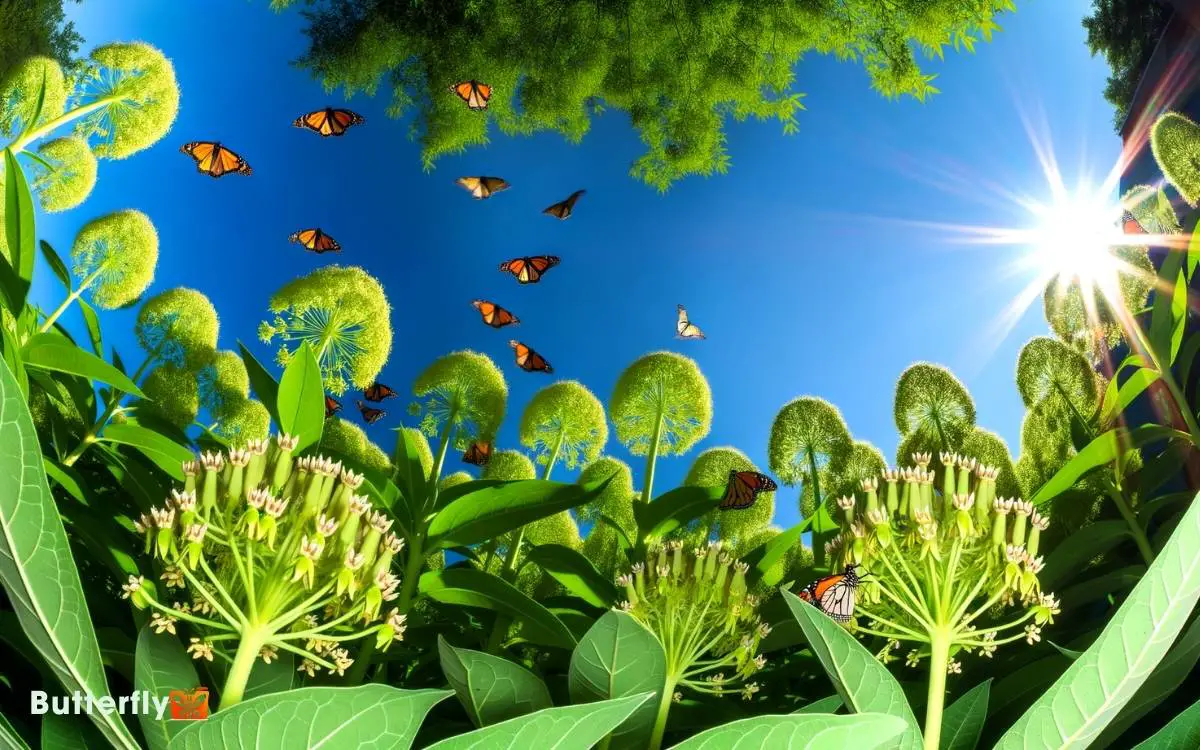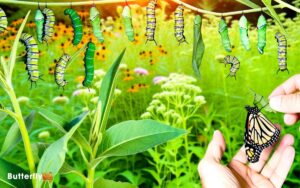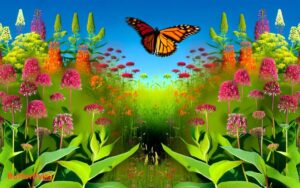How to Attract Monarch Butterfly? Discover Effective Tips!
To attract monarch butterflies, plant native milkweed species like Asclepias syriaca for caterpillars.
Make sure your garden has diverse, nectar-rich flowers such as zinnias and coneflowers for adults. Choose sunny spots and maintain a continuous bloom cycle.
Create dense thickets using native plants like goldenrod and asters to provide shelter from predators and harsh weather.
Provide shallow water sources for hydration and avoid pesticides by using natural pest control methods like ladybugs and organic compost.
Monitor your garden regularly to maintain an inviting habitat. To discover more key strategies, consider nurturing these elements further.

Key Takeaways
Plant Milkweed
Planting milkweed is crucial because it’s the primary food source for monarch caterpillars and essential for their lifecycle.
To begin, choose native milkweed species like Asclepias syriaca (common milkweed) or Asclepias tuberosa (butterfly weed) based on your region.
You’ll want to plant these in sunny locations, as monarchs prefer open, warm areas. Prepare the soil by loosening it and ensuring it’s well-drained.
Sow the seeds directly into the ground, spacing them about 18 inches apart to allow adequate growth. Water them consistently, especially during germination.
As the plants mature, they’ll produce clusters of flowers, providing not just food for caterpillars but also habitats for adult butterflies. By planting milkweed, you’re directly supporting monarch populations.
Provide Nectar Sources
In addition to milkweed, providing a variety of nectar-rich flowers will attract adult monarch butterflies and support their migratory journey. Monarchs rely on these flowers to fuel their long flights and reproductive activities.
Choose diverse, native flowers that bloom at different times to guarantee a continuous nectar supply. Plants like zinnias, coneflowers, and lantanas are excellent choices. Position them in sunny spots, as monarchs prefer warm environments for feeding.
Below is a list of suggested nectar sources to evoke the beauty and necessity of your efforts:
| Flower | Bloom Time | Benefits |
|---|---|---|
| Zinnias | Summer to Fall | Bright colors, easy growth |
| Coneflowers | Late Spring to Fall | Long-lasting blooms, attracts pollinators |
| Lantanas | Spring to Fall | Vibrant clusters, drought-tolerant |
Create Shelter
To create effective shelter for monarch butterflies, you should focus on selecting native plants that provide natural cover. These plants not only offer protection from predators but also support the butterflies’ lifecycle.
Observing local flora can help you identify which species best fulfill these needs.
Native Plant Selection
Choose native plants like milkweed and goldenrod to provide essential shelter and breeding grounds for monarch butterflies. These plants are important for the monarch’s lifecycle, offering both habitat and sustenance.
Selecting the right species guarantees that you cater to their specific needs, fostering a thriving environment for these beautiful insects.
To make informed choices, consider the following:
- Milkweed (Asclepias spp.): Essential for monarch caterpillars, providing both food and a place to pupate.
- Goldenrod (Solidago spp.): Offers nectar to adult butterflies, supporting their energy needs during migration.
- Asters (Symphyotrichum spp.): Bloom late in the season, supplying essential nectar when other sources are scarce.
Protection From Predators
Creating dense thickets with shrubs and tall grasses provides monarch butterflies with essential cover from predators and harsh weather conditions. You’ll want to select native plants like milkweed, goldenrod, and asters, which offer both food and shelter.
Dense foliage creates microhabitats where monarchs can hide from birds, spiders, and other predators. Additionally, these plants act as windbreaks, safeguarding the delicate wings of monarchs from gusty winds.
Incorporate a mix of evergreen and deciduous plants to guarantee year-round protection. Pay attention to plant spacing; closely planted shrubs and grasses simulate a natural habitat, making it harder for predators to spot the butterflies.
Maintain Water Sources
Provide monarch butterflies with access to shallow water sources for hydration and thermoregulation.
To create an ideal environment, make sure these water sources are easily accessible and safe for the butterflies.
Consider the following methods:
- Shallow Puddles: Create shallow, muddy puddles where butterflies can land safely and drink without risk of drowning.
- Moist Sand: Keep a shallow dish filled with moist sand to provide a stable surface for butterflies to absorb water.
- Flat Rocks: Place flat rocks in your garden, misted with water, so butterflies can perch and drink the droplets.
These methods not only provide essential hydration but also help regulate their body temperature, enabling them to thrive. Monitoring these water sources ensures they stay clean and effective for attracting monarchs.
Avoid Pesticides
You should prioritize natural pest control methods to protect monarch butterflies. Employing techniques like introducing beneficial insects and companion planting can effectively manage pests without chemicals.
Natural Pest Control Methods
Why rely on harmful chemicals when natural pest control methods can effectively protect your garden and attract monarch butterflies?
Embrace environmentally friendly alternatives to safeguard both your plants and beneficial insects. By cultivating a healthy ecosystem, you can maintain pest populations at manageable levels without resorting to pesticides.
- Introduce beneficial insects: Ladybugs and lacewings prey on aphids and other harmful pests.
- Implement companion planting: Pair plants like marigolds and nasturtiums to deter pests naturally.
- Use physical barriers: Row covers and netting can prevent pests from reaching your plants.
These methods not only protect your garden but also create a welcoming environment for monarch butterflies. With careful observation and management, you can achieve a thriving, pesticide-free garden that supports diverse wildlife.
Chemical-Free Gardening Practices
Embracing chemical-free gardening practices enhances soil health and fosters a sustainable environment for monarch butterflies.
By avoiding pesticides, you protect not only monarchs but also beneficial insects like bees and ladybugs, which are essential for pollination and natural pest control.
Pesticides can contaminate nectar sources, disrupting monarchs’ feeding and breeding cycles. Instead, rely on companion planting, introducing beneficial insects, and using organic compost to enrich the soil.
These methods create a balanced ecosystem where pests are naturally managed.
Monitor your garden regularly to catch any pest issues early and use physical barriers or hand-picking to address them. This approach not only supports monarch populations but also contributes to a healthier, more resilient garden.
Support Monarch Conservation
Supporting monarch conservation involves creating and maintaining habitats that provide the essential resources monarchs need to thrive. You can make a significant impact by focusing on several key actions.
- Plant Native Milkweed: Monarchs rely on milkweed for laying eggs and feeding caterpillars. Choose species native to your region.
- Avoid Pesticides: Chemicals can harm monarchs at various life stages. Opt for natural pest control methods to guarantee a safe environment.
- Create Pollinator Gardens: Include nectar-rich flowers like zinnias, coneflowers, and goldenrod to provide sustenance for adult butterflies.
Conclusion
By planting milkweed, providing nectar sources, creating shelter, maintaining water sources, and avoiding pesticides, you’re crafting a sanctuary for monarch butterflies.
Picture your garden as a safe haven, teeming with life and color, where monarchs can thrive. Each fluttering visitor isn’t just a beautiful sight; it’s a step towards supporting monarch conservation.
Your efforts will help these delicate creatures flourish, ensuring their migration dance continues for generations.
Now, go transform your space into a monarch paradise!






